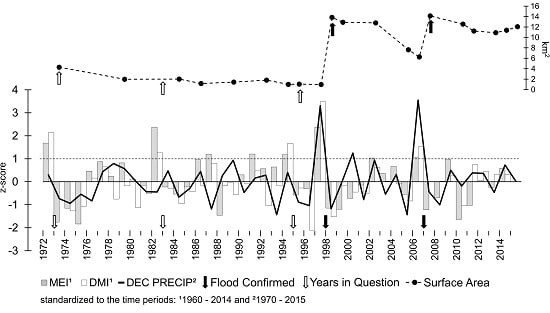Surface Area Variability of a North-Central Tanzanian Crater Lake
Abstract
:1. Introduction
2. Materials and Methods
2.1. Study Location
2.2. Methods
3. Results with Discussion
4. Conclusions
Supplementary Materials
Acknowledgments
Author Contributions
Conflicts of Interest
Abbreviations
| IOD | Indian Ocean Dipole |
| ITCZ | Intertropical Convergence Zone |
| SST | Sea Surface Temperature |
| DMI | Dipole Mode Index |
| DEM | Digital Elevation Model |
| SRTM | Shuttle Radar Topography |
| USGS | United States Geologic Survey |
| NIR | Near Infrared |
| SWIR | Shortwave Infrared |
| GPCC | Global Precipitation and Climatology Center v6 |
| MEI | Multivariate El Niño-Southern Oscillation Index |
| OND | October, November, December |
| STD | Standard Deviation |
References
- Generators’ Disturbing Lake Bassuto Gods and Spirits’. The Arusha Times. 30 July–5 August 2011. Available online: http://www.arushatimes.co.tz/2011/28/Local%20News_5.htm (accessed on 7 April 2016).
- RC Mbwilo Wants Lasting Solution for Lake Bassotu Crisis. The Arusha Times. 10–16 December 2011. Available online: http://www.arushatimes.co.tz/2011/45/Local%20News_7.html (accessed on 7 April 2016).
- District Authorities Fail to Protect Lake Bassotu. The Citizen Reporter. 9 February 2013. Available online: http://www.thecitizen.co.tz/News/District-authorities-fail-to-protect-Lake-Bassotu/-/1840392/1976394/-/2h8so2/-/index.html (accessed on 7 April 2016).
- The Overseas Development Institute. Tanzania National Climate Change Finance Analysis. 2014. Available online: http://www.odi.org/publications/7908-tanzania-national-climate-change-finance-analysis (accessed on 8 February 2016).
- FloodList. Tanzania—Floods in Dar es Salaam Leave 12 Dead. 13 May 2015. Available online: http://floodlist.com/africa/tanzania-floods-dar-es-salaam-may-2015 (accessed on 8 February 2016).
- FloodList. 38 Dead after Floods in Tanzania. 4 March 2015. Available online: http://floodlist.com/africa/38-dead-floods-tanzania-shinyanga (accessed on 8 February 2016).
- Intergovernmental Panel on Climate Change (IPCC). Climate Change 2014: Synthesis Report. Contribution of Working Groups I, II and III to the Fifth Assessment Report of the Intergovernmental Panel on Climate Change. Available online: http://ar5-syr.ipcc.ch/ipcc/ipcc/resources/pdf/IPCC_SynthesisReport.pdf (accessed on 8 February 2016).
- Brady, N.C.; Weil, R.R. The Nature and Properties of Soils, 13th ed.; Prentice Hall: Upper Saddle River, NJ, USA, 2008; pp. 100–103. [Google Scholar]
- Berry, L. Environmental Impact of Agricultural Development in Tanzania; Clark University: Worcester, MA, USA, 1975. [Google Scholar]
- Kijazi, A.L.; Reason, C.J.C. Analysis of the 2006 floods over northern Tanzania. Int. J. Climatol. 2009, 29, 955–970. [Google Scholar] [CrossRef]
- Food and Agriculture Organization of the United Nations. Special Report: Heavy Rains Attributed to El Niño Cause Extensive Crop Damage in Parts of Eastern Africa. 1998. Available online: http://www.fao.org/docrep/004/w7832e/w7832e00.HTM (accessed on 10 August 2015).
- Trenberth, K.E. The definition of El Niño. Bull. Am. Meteorol. Soc. 1997, 78, 2771–2777. [Google Scholar] [CrossRef]
- Ropelewski, C.F.; Halpert, M.S. Global and regional scale precipitation patterns associated with the El Niño/Southern Oscillation. Mon. Weather Rev. 1987, 115, 985–996. [Google Scholar] [CrossRef]
- Anyamba, A.; Tucker, C.J.; Eastman, J.R. NDVI anomaly patterns over Africa during the 1997/98 ENSO warm event. Int. J. Remote Sens. 2001, 22, 1847–1859. [Google Scholar]
- Saji, N.H.; Goswami, B.N.; Vinayachandran, P.N.; Yamagata, T. A dipole mode in the tropical Indian Ocean. Nature 1999, 401, 360–363. [Google Scholar] [CrossRef] [PubMed]
- Rayner, N.A.; Parker, D.E.; Horton, E.B.; Folland, C.K.; Alexander, L.V.; Rowell, D.P.; Kenty, E.C.; Kaplan, A. Global analyses of sea surface temperature, sea ice, and night marine air temperature since the late nineteenth century. J. Geophys. Res. 2003, 108. [Google Scholar] [CrossRef]
- Mvungi, S.E. Study on Options for Pastoralists to Secure Their Livelihoods: Experiences in the Defense of Pastoralists Resource Rights in Tanzania: Lessons and Prospects. 2007. Available online: http://www.tnrf.org/files/E-INFO-RLTF_VOL2-PART4_Mvungi-S_2008_Experiences_in_the_defence_of_pastoralist_rights_PART-B.pdf (accessed on 8 February 2016).
- Legal and Human Rights Centre. Human Rights and Business Report in Tanzania—2013. 2014. Available online: http://www.humanrights.or.tz/downloads/LHRC%20Business%20Rep%202013.pdf (accessed on 8 February 2016).
- Anonymous. Sediment Based Paleoenvironmental Variations of Lake Basotu, Tanzania. Manuscript in Preparation.
- Survey Division of the Ministry of Lands, Settlement and Water Development. Geological Map. Tanzania Quarter Degree Sheet 84 [map]; Hanang. Scale: 1:125,000; Government of Tanzania: Dodoma, Tanzania, 1966.
- United States Geological Survey. EarthExplorer. Available online: http://earthexplorer.usgs.gov/ (accessed on 26 April 2016).
- United States Geological Survey. Landsat Processing Details. 2016. Available online: http://landsat.usgs.gov/Landsat_Processing_Details.php (accessed on 26 March 2016). [Google Scholar]
- Goward, S.; Arvidson, T.; Williams, D. Historical record of landsat global coverage. Photogramm. Eng. Remote Sens. 2006, 72, 1155. [Google Scholar] [CrossRef]
- Ballatore, T.J.; Bradt, S.R.; Olaka, L.; Cózar, A.; Loiselle, S.A. Chapter 20: Remote Sensing of African Lakes: A Review. In Remote Sensing of the African Seas; Springer Netherlands: Dordrecht, The Netherlands, 2014; pp. 403–422. [Google Scholar]
- Environmental Systems Resource Institute (ESRI). ArcMap 10.3.1; ESRI: Redlands, CA, USA, 2015. [Google Scholar]
- Sannel, A.B.K.; Brown, I.A. High-resolution remote sensing identification of thermokarst lake dynamics in a subarctic peat plateau complex. Can. J. Remote Sens. 2010, 36, S26–S40. [Google Scholar] [CrossRef]
- Markham, B.L.; Storey, J.C.; Williams, D.L.; Irons, J.R. Landsat sensor performance: History and current status. IEEE Trans. Geosci. Remote Sens. 2004, 42, 2691–2694. [Google Scholar] [CrossRef]
- United States Geological Survey (USGS). Shuttle Radar Topography Mission, 1 Arc-Second Global scenes SRTM1S04E033V3, SRTM1S04E034V3, SRTM1S04E035V3, SRTM1S04E036V3, SRTM1S05E033V3, SRTM1S05E034V3, SRTM1S05E035V3, SRTM1S05E036V3, SRTM1S06E033V3, SRTM1S06E034V3, SRTM1S06E035V3, & SRTM1S06E036V3, Global Land Cover Facility; University of Maryland: College Park, MD, USA, 2000.
- Becker, A.; Finger, P.; Meyer-Christoffer, A.; Rudolf, B.; Schamm, K.; Schneider, U.; Ziese, M. A description of the global land-surface precipitation data products of the global precipitation climatology centre with sample applications including centennial (trend) analysis from 1901–present. Earth Syst. Sci. Data 2013, 5, 71–99. [Google Scholar] [CrossRef]
- Koutsouris, A.J.; Chen, D.; Lyon, S.W. Comparing global precipitation data sets in eastern Africa: A case study of Kilombero Valley, Tanzania. Int. J. Climatol. 2015, 36, 2000–2014. [Google Scholar] [CrossRef]
- Themeßl, J.M.; Gobiet, A.; Leuprecht, A. Empirical-statistical downscaling and error correction of daily precipitation from regional climate models. Int. J. Climatol. 2010, 31, 1530–1544. [Google Scholar] [CrossRef]
- Kilham, P.; Cloke, P.L. The evolution of saline lake waters: Gradual and rapid biogeochemical pathways in the Basotu Lake District, Tanzania. Hydrobiologia 1990, 197, 35–50. [Google Scholar] [CrossRef]
- White, J.D.L.; Ross, P.S. Maar-diatreme volcanoes: A review. J. Volcanol. Geotherm. Res. 2011, 201, 1–29. [Google Scholar] [CrossRef]
- Conway, D. Extreme rainfall events and lake level changes in East Africa: recent events and historical precedents. In The East African Great Lakes: Limnology, Palaeolimnology and Biodiversity; Springer Netherlands: Dordrecht, The Netherlands, 2002; pp. 63–92. [Google Scholar]
- Conway, D.; Allison, E.; Felstead, R.; Goulden, M. Rainfall variability in East Africa: Implications for natural resources management and livelihoods. Philos. Trans. A Math. Phys. Eng. Sci. 2005, 363, 49–54. [Google Scholar] [CrossRef] [PubMed]
- The Arusha Times. Local Conflicts Fueled by Politicians—Claim. 13–19 August 2011. Available online: http://www.arushatimes.co.tz/2011/30/Local%20News_4.htm (accessed on 8 February 2016).
- Folster, N. Systemic Constraints on Aid Policy and Aid Outcomes: The History of Canadian Official Development Assistance to Tanzania. Ph.D. Thesis, London School of Economics and Political Science, London, UK, 2001. [Google Scholar]
- Antapa, P.L. An analysis of research required to address constraints to rainfed, large-scale, mechanized wheat production in Northern Tanzania. In Proceedings of the 1994 Regional Travelling Workshop on Long-Term Wheat-Based Sustainability Trials in East Africa, Addis Ababa, Ethiopia, 7–18 February 1994; pp. 47–61.
- Florinsky, I.G.; Arlashina, H.A. Quantitative topographic analysis of gilgai soil morphology. Geoderma 1998, 82, 359–380. [Google Scholar] [CrossRef]
- Human activities threaten Lake Bassotu. PESA Times. 30 July 2013. Available online: http://pesatimes.co.tz/news/environment/human-activities-threaten-lake-bassotu/ (accessed on 7 April 2016).
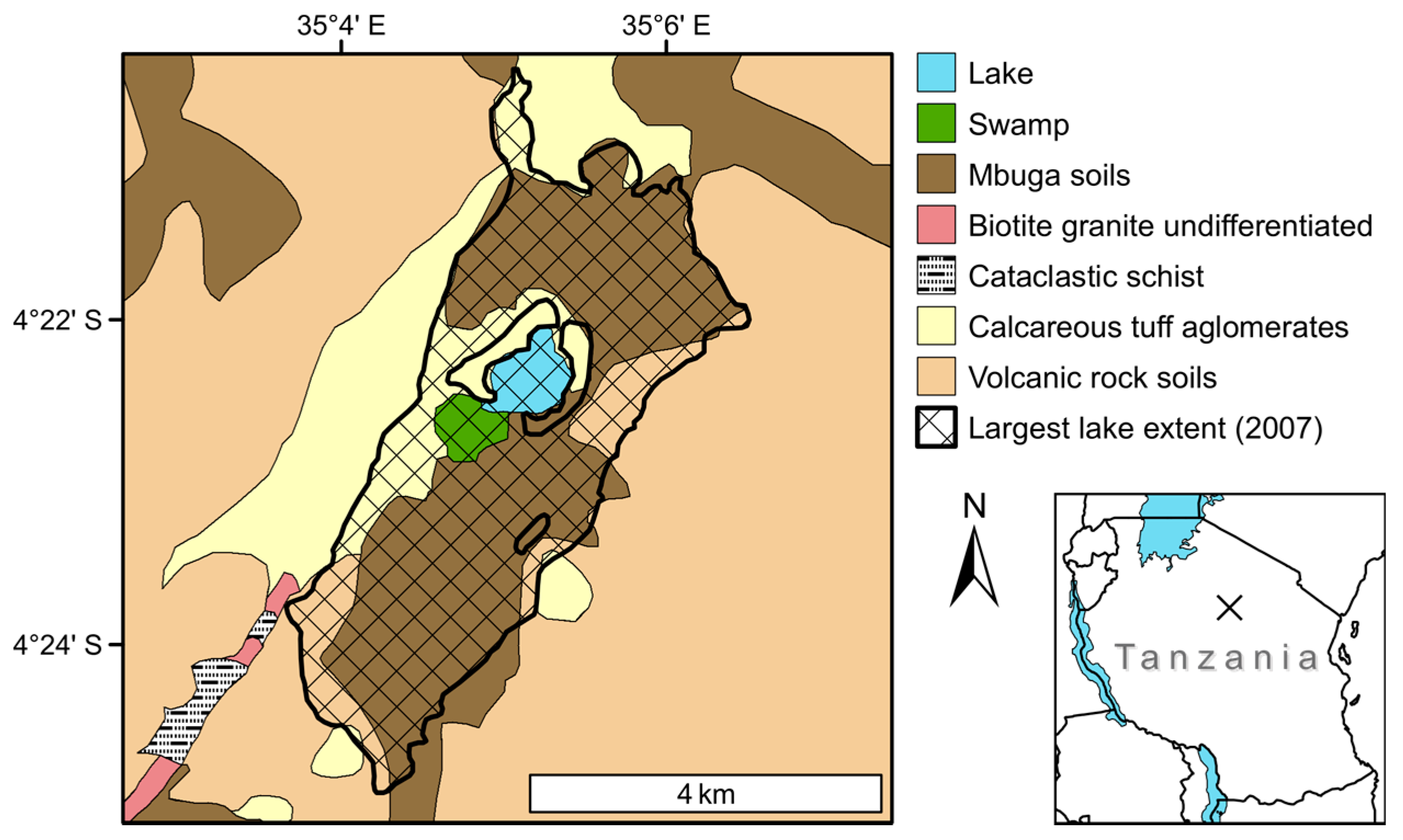
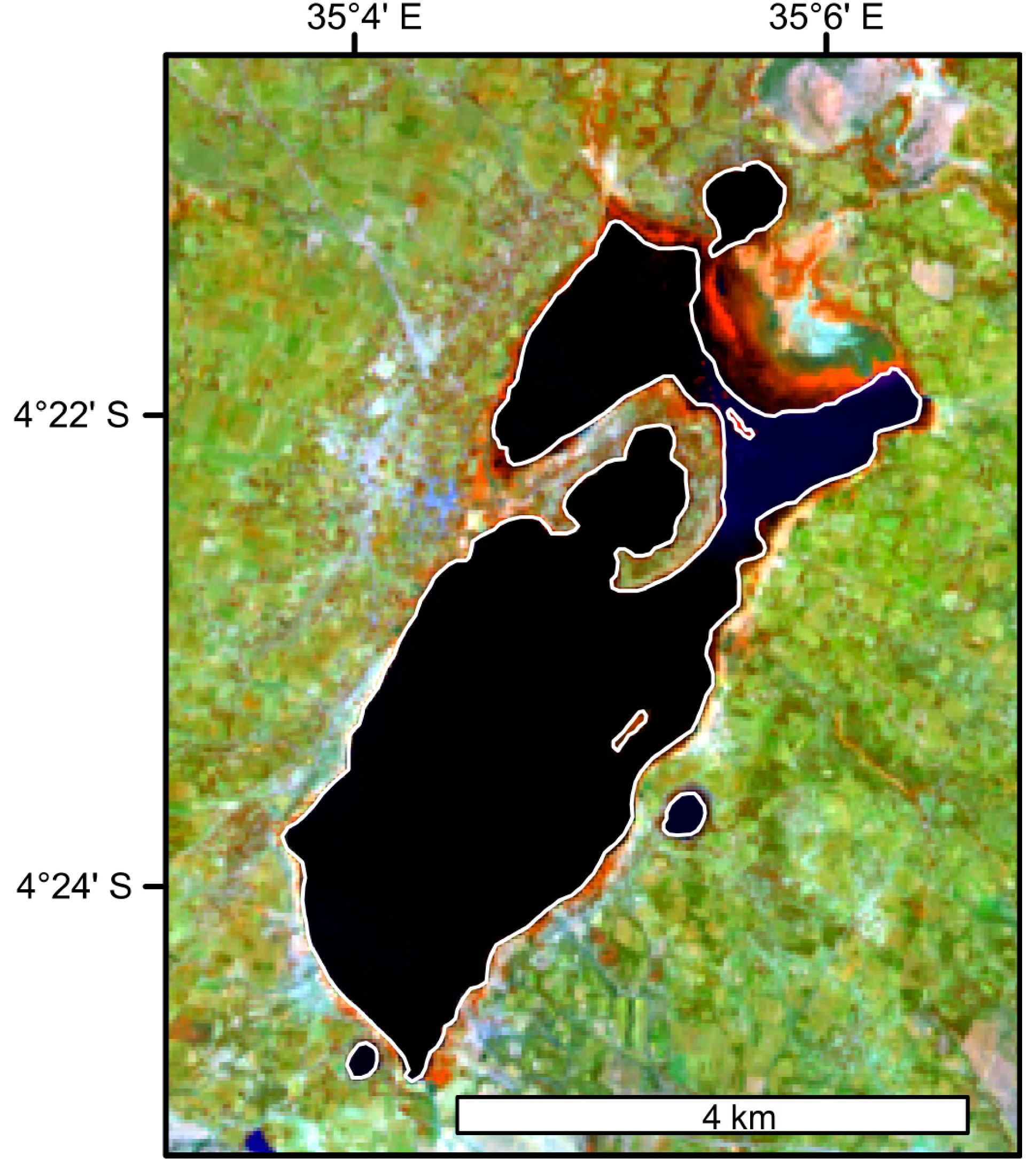
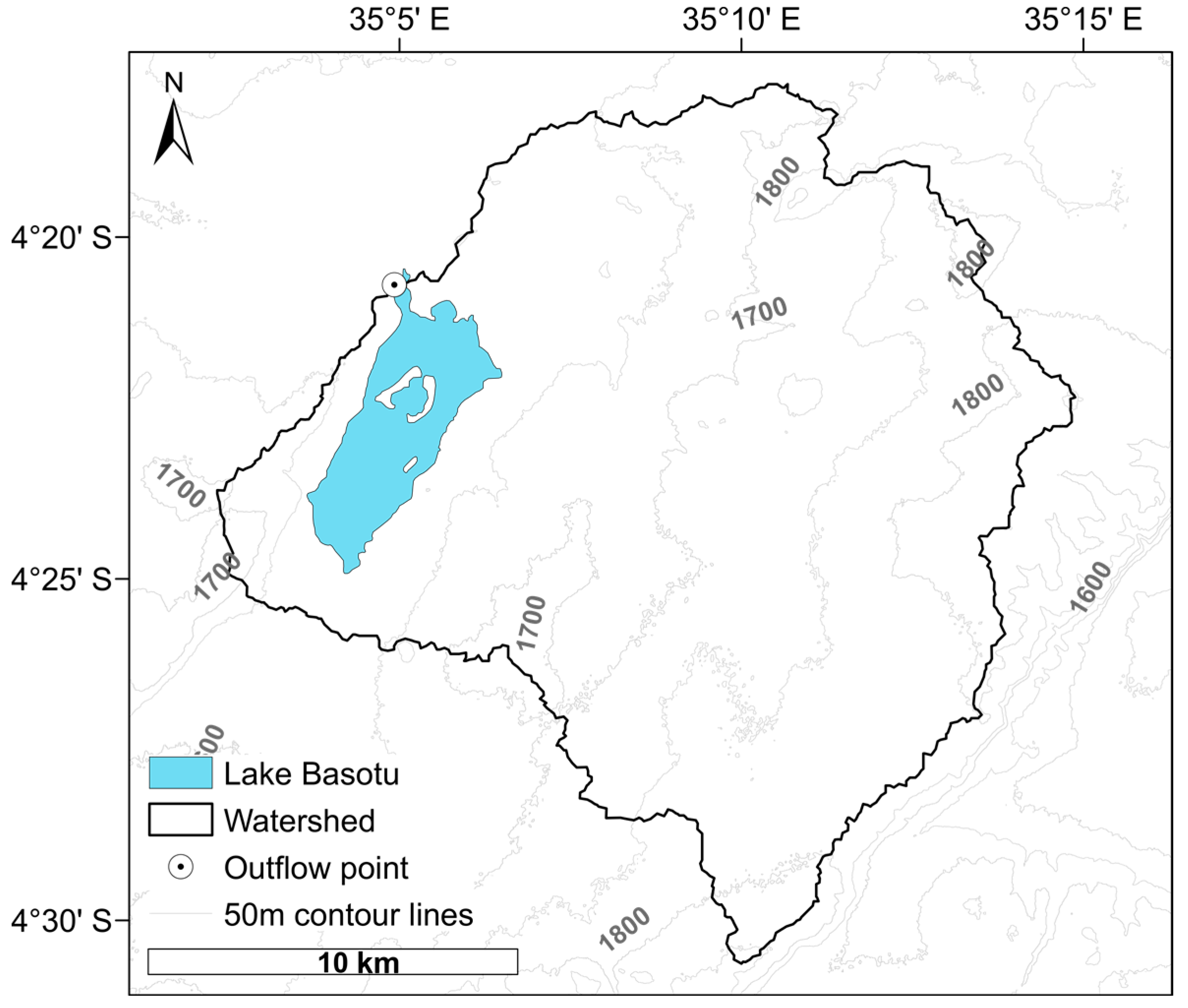
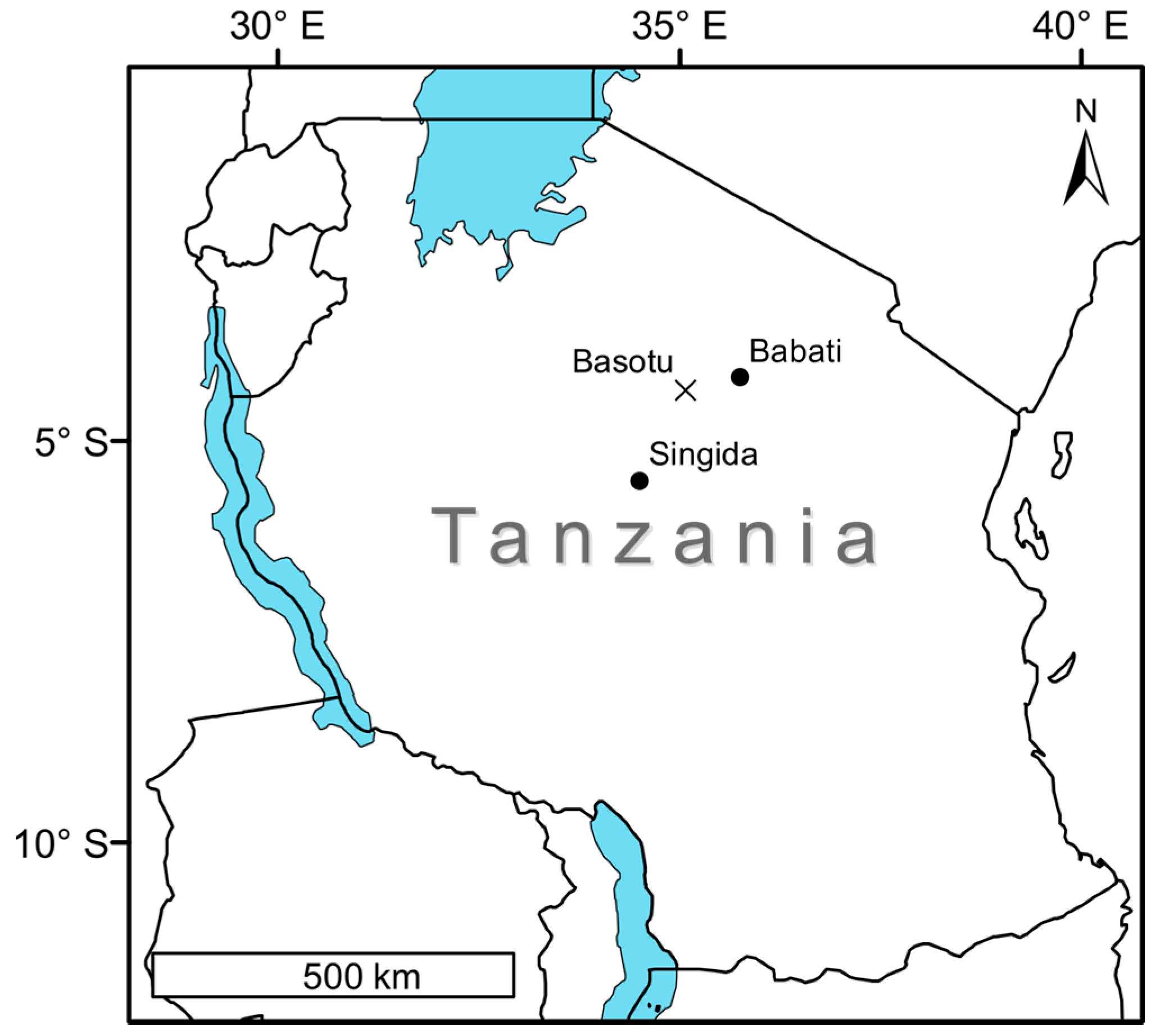
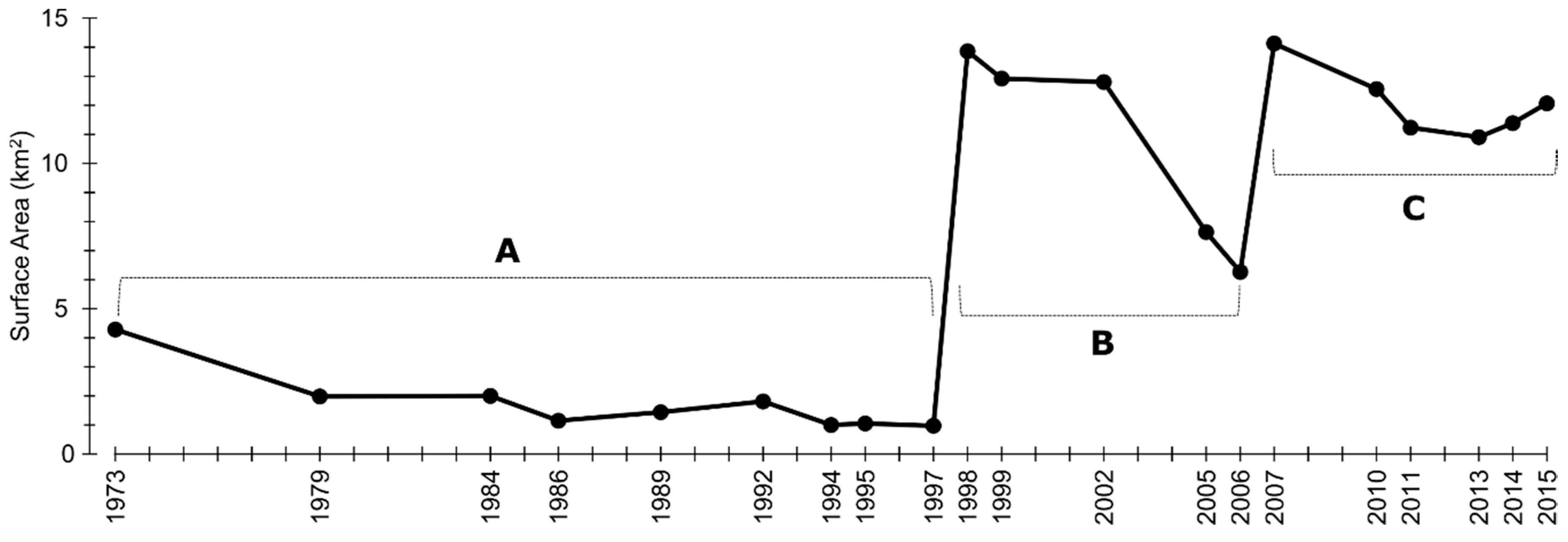


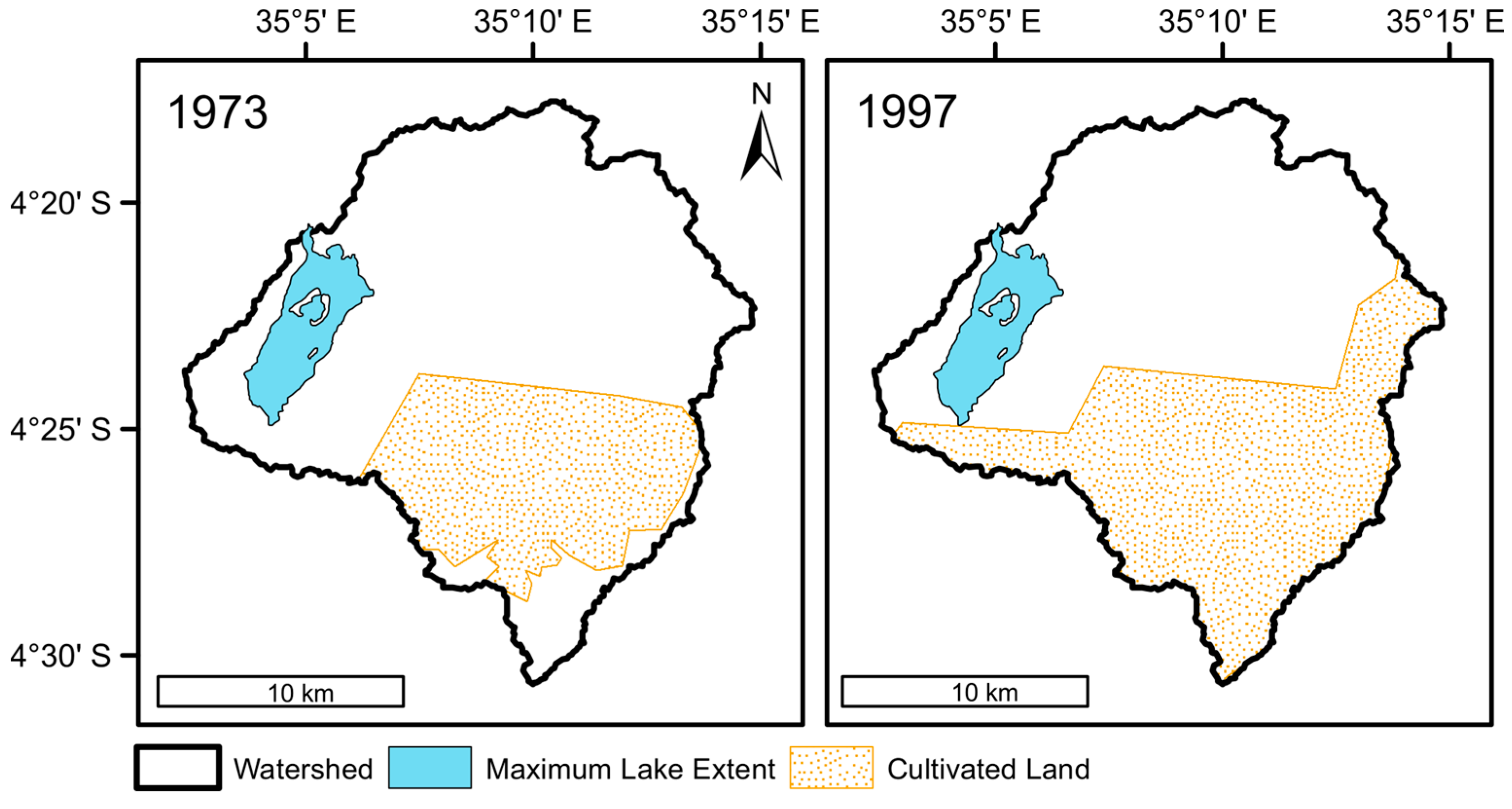
| Date | Surface Area (km2) | Date | Surface Area (km2) |
|---|---|---|---|
| 22 September 1973 | 4.28 | 5 September 1999 | 12.92 |
| 29 June 1979 | 1.99 | 15 October 2002 | 12.80 |
| 3 September 1984 | 2.00 | 7 October 2005 | 7.64 |
| 8 August 1986 | 1.15 | 16 October 2006 | 6.27 |
| 17 September 1989 | 1.44 | 29 October 2007 | 14.12 |
| 11 October 1992 | 1.81 | 5 October 2010 | 12.56 |
| 17 October 1994 | 1.00 | 22 September 2011 | 11.23 |
| 30 June 1995 | 1.05 | 21 October 2013 | 10.90 |
| 22 August 1997 | 0.97 | 24 October 2014 | 11.38 |
| 26 September 1998 | 13.86 | 23 July 2015 | 12.07 |
© 2016 by the authors; licensee MDPI, Basel, Switzerland. This article is an open access article distributed under the terms and conditions of the Creative Commons Attribution (CC-BY) license (http://creativecommons.org/licenses/by/4.0/).
Share and Cite
Higgins, L.; Koutsouris, A.J.; Westerberg, L.-O.; Risberg, J. Surface Area Variability of a North-Central Tanzanian Crater Lake. Geosciences 2016, 6, 27. https://doi.org/10.3390/geosciences6020027
Higgins L, Koutsouris AJ, Westerberg L-O, Risberg J. Surface Area Variability of a North-Central Tanzanian Crater Lake. Geosciences. 2016; 6(2):27. https://doi.org/10.3390/geosciences6020027
Chicago/Turabian StyleHiggins, Lindsey, Alexander J. Koutsouris, Lars-Ove Westerberg, and Jan Risberg. 2016. "Surface Area Variability of a North-Central Tanzanian Crater Lake" Geosciences 6, no. 2: 27. https://doi.org/10.3390/geosciences6020027
APA StyleHiggins, L., Koutsouris, A. J., Westerberg, L.-O., & Risberg, J. (2016). Surface Area Variability of a North-Central Tanzanian Crater Lake. Geosciences, 6(2), 27. https://doi.org/10.3390/geosciences6020027





